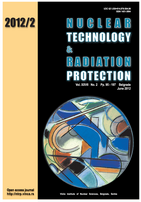
EFFECTIVE ATOMIC NUMBERS, ELECTRON DENSITIES, AND TISSUE EQUIVALENCE OF SOME GASES AND MIXTURES FOR DOSIMETRY OF RADIATION DETECTORS
Pages: 117-124
Authors: Vishwanath P. Singh, Nagappa M. Badiger
Abstract
Total mass attenuation coefficients, µm, effective atomic number, Zeff, and effective electron density, Neff, of different gases – carbon dioxide, methane, acetylene, propane, butane, and pentane used in radiation detectors, have been calculated for the photon energy of 1 keV to 100 GeV. Each gas has constant Zeff values between 0.10 to 10 MeV photon energies; however, these values are way far away from ICRU tissue. Carbon dioxide gas shows the closest tissue equivalence in the entire photon energy spectrum. Relative tissue equivalences of the mixtures of gases with respect to ICRU tissue are in the range of 0.998-1.041 for air, argon (4.5%) + methane (95.5%), argon (0.5%) + carbon dioxide (99.5%), and nitrogen (5%) + methane (7%) + carbon dioxide (88%). The gas composition of xenon (0.5%) + carbon dioxide (99.5%) shows 1.605 times higher tissue equivalence compared to the ICRU tissue. The investigated photon interaction parameters are useful for exposure and energy absorption buildup factors calculation and design, and fabrication of gaseous detectors for ambient radiation measurement by the Geiger-Muller detector, ionization chambers and proportional counters.
Key words: effective atomic number, gamma detector, tissue equivalent, reactor, hydrocarbons, inert gases
FULL PAPER IN PDF FORMAT (715 KB)
